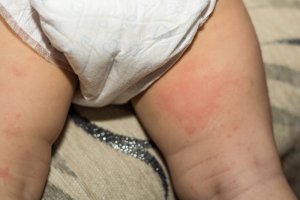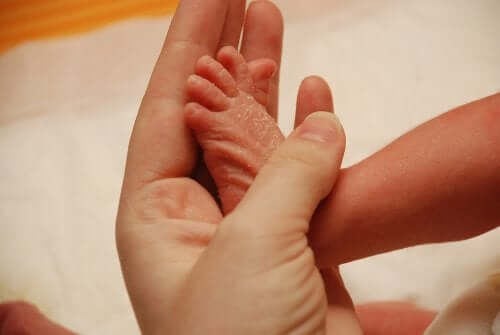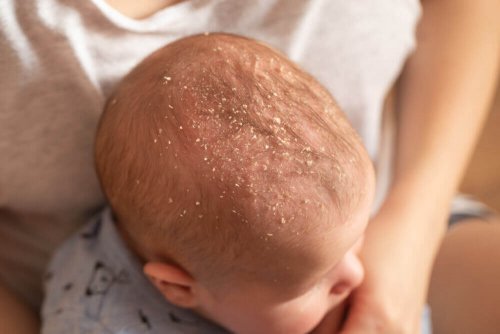Seborrheic Dermatitis in Children

Seborrheic dermatitis in children isn’t always considered a disease, but the symptomatic manifestation of other skin disorders. It’s a chronic condition that must be differentiated from atopic dermatitis.
Seborrheic dermatitis in children
Where is it located?
Seborrheic dermatitis shouldn’t be confused with atopic dermatitis. This is because the former is a milder condition that only affects the scalp and the oily areas of the face, such as the area around the eyebrows, nasal grooves, or chin. However, atopic dermatitis mostly causes injuries on the limbs, neck, eyelids, and lip area.
When seborrheic dermatitis occurs in infants and only affects the scalp, it’s called cradle cap. In this regard, it can spread to the face and the diaper area. In this case, it’s also called seborrheic dermatitis because it occurs where the greatest number of sebaceous glands that produce oil or sebum are located.
It’s worth mentioning that seborrheic dermatitis is a non-infectious skin condition that’s very common in children. Usually, it begins in the first weeks of life and slowly disappears after a few weeks or months. Unlike eczema or contact dermatitis, seborrheic dermatitis in children is uncomfortable and sometimes causes irritability.

It’s essential to note that it isn’t contagious, because this is an issue that worries parents and, if left undetected, can lead to stigmatization.
Causes and treatments
Identifying the causes of seborrheic dermatitis in children is no easy task. However, it may be related to a combination of factors and it’s even possible to cite the following:
- Sebaceous gland activity.
- Yeasts that inhabit the skin, especially in areas with more sebaceous glands.
- Changes in skin microbiota.
- Genetic conditions.
Regarding treatment, it’s appropriate to distinguish whether we’re dealing with seborrheic dermatitis that manifests in babies and in the scalp (cradle cap) or that manifests with skin lesions and in older children.
Treatment of cradle cap and seborrheic dermatitis in children
- Wash your baby’s hair with baby shampoo that doesn’t cause eye irritation.
- Carefully remove the scales and, if they don’t easily come off, apply a few drops of mineral oil on your baby’s scalp.
- Unlike what people assume, it’s preferable to avoid performing inopportune movements to remove the scales because they can injure the scalp and further stimulate grandular secretion.

For seborrhea in other parts of the body, the medical professional may also recommend a gentle cream that contains steroids or antifungals. The latter is a medication that fights fungi but requires a prescription.
Treatment for adults
Scales and skin dryness can be treated with over-the-counter dandruff or medicated shampoos. These products contain ingredients such as salicylic acid, coal tar, zinc, resorcin, ketoconazole, or selenium sulfide.
In conclusion
It’s important to avoid self-medicating, as it may disguise or modify the injuries, consequently making it harder for a medical professional to make a proper diagnosis.
Seborrheic dermatitis in children isn’t always considered a disease, but the symptomatic manifestation of other skin disorders. It’s a chronic condition that must be differentiated from atopic dermatitis.
Seborrheic dermatitis in children
Where is it located?
Seborrheic dermatitis shouldn’t be confused with atopic dermatitis. This is because the former is a milder condition that only affects the scalp and the oily areas of the face, such as the area around the eyebrows, nasal grooves, or chin. However, atopic dermatitis mostly causes injuries on the limbs, neck, eyelids, and lip area.
When seborrheic dermatitis occurs in infants and only affects the scalp, it’s called cradle cap. In this regard, it can spread to the face and the diaper area. In this case, it’s also called seborrheic dermatitis because it occurs where the greatest number of sebaceous glands that produce oil or sebum are located.
It’s worth mentioning that seborrheic dermatitis is a non-infectious skin condition that’s very common in children. Usually, it begins in the first weeks of life and slowly disappears after a few weeks or months. Unlike eczema or contact dermatitis, seborrheic dermatitis in children is uncomfortable and sometimes causes irritability.

It’s essential to note that it isn’t contagious, because this is an issue that worries parents and, if left undetected, can lead to stigmatization.
Causes and treatments
Identifying the causes of seborrheic dermatitis in children is no easy task. However, it may be related to a combination of factors and it’s even possible to cite the following:
- Sebaceous gland activity.
- Yeasts that inhabit the skin, especially in areas with more sebaceous glands.
- Changes in skin microbiota.
- Genetic conditions.
Regarding treatment, it’s appropriate to distinguish whether we’re dealing with seborrheic dermatitis that manifests in babies and in the scalp (cradle cap) or that manifests with skin lesions and in older children.
Treatment of cradle cap and seborrheic dermatitis in children
- Wash your baby’s hair with baby shampoo that doesn’t cause eye irritation.
- Carefully remove the scales and, if they don’t easily come off, apply a few drops of mineral oil on your baby’s scalp.
- Unlike what people assume, it’s preferable to avoid performing inopportune movements to remove the scales because they can injure the scalp and further stimulate grandular secretion.

For seborrhea in other parts of the body, the medical professional may also recommend a gentle cream that contains steroids or antifungals. The latter is a medication that fights fungi but requires a prescription.
Treatment for adults
Scales and skin dryness can be treated with over-the-counter dandruff or medicated shampoos. These products contain ingredients such as salicylic acid, coal tar, zinc, resorcin, ketoconazole, or selenium sulfide.
In conclusion
It’s important to avoid self-medicating, as it may disguise or modify the injuries, consequently making it harder for a medical professional to make a proper diagnosis.
This text is provided for informational purposes only and does not replace consultation with a professional. If in doubt, consult your specialist.








